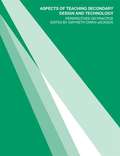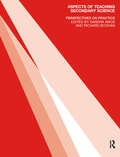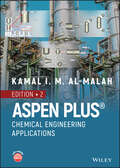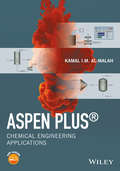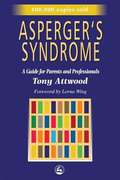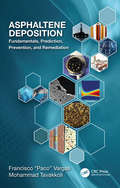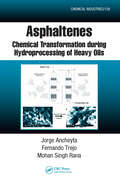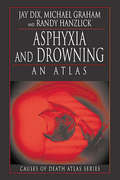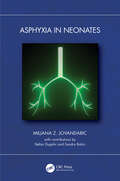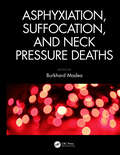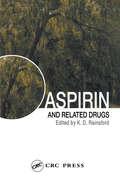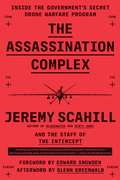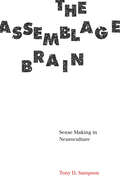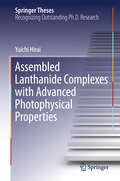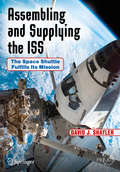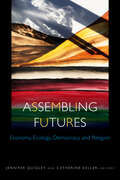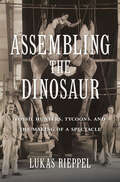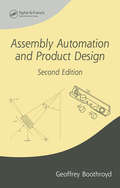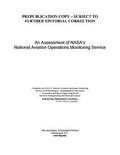- Table View
- List View
Aspects of Scientific Explanation: and Other Essays in the Philosophy Of Science
by Carl G. HempelIn this volume address themselves to one or another of four major topics in the philosophy of science, and have accordingly been grouped under the headings "Confirmation, Induction, and Rational Belief," "Conceptions of Cognitive Significance," "Structure and Function of Scientific Concepts and Theories," and "Scientific Explanation.
Aspects of symmetry
by Sidney ColemanThis collection of review lectures on topics in theoretical high energy physics has few rivals for clarity of exposition and depth of insight. Delivered over the past two decades at the International School of Subnuclear Physics in Erice, Sicily, the lectures help to organize and explain material that a the time existed in a confused state, scattered in the literature. At the time they were given they spread new ideas throughout the physics community and proved very popular as introductions to topics at the frontiers of research.
Aspects of Teaching Secondary Design and Technology: Perspectives on Practice
by Gwyneth Owen-JacksonBeginning by outlining the national curriculum for design and technology, Aspects of Teaching Secondary Design and Technology goes on to look at what design and technology is in the primary school, at examination level and post-16. Vocational qualifications relevant to design and technology are also discussed. There are chapters looking at the relationship between design and technology and the wider social and cultural context. The development of cross-curricular skills and value judgements are discussed as are sustainability and the role of the community in the teaching and learning of design and technology. Together, these articles comprise a sound guide to good classroom practice, related to the requirements of the curriculum, and rooted in the professional perspectives of experienced teachers.
Aspects of Teaching Secondary Science: Perspectives on Practice
by Sandra Amos Richard BoohanThis book's structure reflects the different dimensions to learning science. The first section focuses on the importance of talk in the science classroom, while the second explores the key role of practical work. The third section is concerned with the creative, theoretical aspect of science. Section four follows this by considering the communication of ideas and how pupils learn to participate in the discourse of the scientific community. Section five emphasizes the place of science in the broader context, considering its moral and ethical dimensions and its place in a cultural context. Finally, section six explores the complexity of the task faced by science teachers, highlighting the knowledge and skills science teachers must acquire in order to create an environment in which students are motivated to learn science.
Aspects of WIMP Dark Matter Searches at Colliders and Other Probes (Springer Theses)
by Enrico MorganteThis thesis covers several theoretical aspects of WIMP (weakly interacting massive particles) dark matter searches, with a particular emphasis on colliders. It mainly focuses on the use of effective field theories as a tool for Large Hadron Collider (LHC) searches, discussing in detail the issue of their validity, and on simplified dark matter models, which are receiving a growing attention from the physics community. It highlights the theoretical consistency of simplified models, which is essential in order to correctly exploit their potential and for them to be a common reference when comparing results from different experiments. This thesis is of interest to researchers (both theorists and experimentalists) in the field of dark matter searches, and offers a comprehensive introduction to dark matter and to WIMP searches for students and non-experts.
Aspen Plus: Chemical Engineering Applications
by Kamal I. Al-MalahASPEN PLUS® Comprehensive resource covering Aspen Plus V12.1 and demonstrating how to implement the program in versatile chemical process industries Aspen Plus®: Chemical Engineering Applications facilitates the process of learning and later mastering Aspen Plus®, the market-leading chemical process modeling software, with step-by-step examples and succinct explanations. The text enables readers to identify solutions to various process engineering problems via screenshots of the Aspen Plus® platforms in parallel with the related text. To aid in information retention, the text includes end-of-chapter problems and term project problems, online exam and quiz problems for instructors that are parametrized (i.e., adjustable) so that each student will have a standalone version, and extra online material for students, such as Aspen Plus®-related files, that are used in the working tutorials throughout the entire textbook. The second edition of Aspen Plus®: Chemical Engineering Applications includes information on: Various new features that were embedded into Aspen Plus V12.1 and existing features which have been modified Aspen Custom Modeler (ACM), covering basic features to show how to merge customized models into Aspen Plus simulator New updates to process dynamics and control and process economic analysis since the first edition was published Vital areas of interest in relation to the software, such as polymerization, drug solubility, solids handling, safety measures, and energy saving For chemical engineering students and industry professionals, the second edition of Aspen Plus®: Chemical Engineering Applications is a key resource for understanding Aspen Plus and the new features that were added in version 12.1 of the software. Many supplementary learning resources help aid the reader with information retention.
Aspen Plus: Chemical Engineering Applications
by Kamal I.M. Al-MalahFacilitates the process of learning and later mastering Aspen Plus® with step by step examples and succinct explanations Step-by-step textbook for identifying solutions to various process engineering problems via screenshots of the Aspen Plus® platforms in parallel with the related text Includes end-of-chapter problems and term project problems Includes online exam and quiz problems for instructors that are parametrized (i.e., adjustable) so that each student will have a standalone version Includes extra online material for students such as Aspen Plus®-related files that are used in the working tutorials throughout the entire textbook
Asperger's Syndrome: A Guide for Parents and Professionals
by Tony AttwoodA book designed for parents and teachers alike on Asperger's Syndrome. The information in this book is also applicable to individuals who are labeled as high functioning Autism. An excelent resource for anyone who works with an individual with a disorder on the autism spectrum.
The Aspergilli: Genomics, Medical Aspects, Biotechnology, and Research Methods (Mycology)
by Gustavo H. Goldman Stephen A. OsmaniWith high-quality genome sequences for the important and ubiquitous Aspergilli now available, increased opportunities arise for the further understanding of its gene function, interaction, expression, and evolution. The Aspergilli: Genomics, Medical Aspects, Biotechnology, and Research Methods provides a comprehensive analysis of the researc
Asphaltene Deposition: Fundamentals, Prediction, Prevention, and Remediation
by Francisco M. Vargas and Mohammad TavakkoliAs global consumption of fossil fuels such as oil increases, previously abundant sources have become depleted or plagued with obstructions. Asphaltene deposition is one of such obstructions which can significantly decrease the rate of oil production. This book offers concise yet thorough coverage of the complex problem of asphaltene precipitation and deposition in oil production. It covers fundamentals of chemistry, stabilization theories and mechanistic approaches of asphaltene behavior at high temperature and pressure. Asphaltene Deposition: Fundamentals, Prediction, Prevention, and Remediation explains techniques for experimental determination of asphaltene precipitation and deposition and different modeling tools available to forecast the occurrence and magnitude of asphaltene deposition in a given oil field. It discusses strategies for mitigation of asphaltene deposition using chemical inhibition and corresponding challenges, best practices for asphaltene remediation, current research, and case studies.
Asphaltenes: Chemical Transformation during Hydroprocessing of Heavy Oils (Chemical Industries)
by Jorge Ancheyta Fernando Trejo Mohan Singh RanaDuring the upgrading of heavy petroleum, asphaltene is the most problematic impurity since it is the main cause of catalyst deactivation and sediments formation. Exploring many aspects related to asphaltenes composition and conversion, Asphaltenes: Chemical Transformation during Hydroprocessing of Heavy Oils highlights the various changes that thes
Asphyxia and Drowning: An Atlas (Cause of Death Atlas Series)
by Jay Dix Michael Graham Randy HanzlickThis third volume in the Forensic Pathology Atlases: Causes of Death Series provides an overview of the types, mechanisms, and physical findings associated with deaths involving asphyxia. Asphyxia and Drowning serves as a basic framework for an extensive pictorial representation of findings associated with these types of deaths. It helps the reader
Asphyxia in Neonates
by Miljana Z. JovandaricIn severe asphyxia, lipid peroxidation occurs. Neonatal lipid concentration may indicate the severity of asphyxia and be a reason for needing cooling therapy. Asphyxia in Neonates describes the results of research into the impact oxygen deficits in neonates. The physiological consequences of asphyxiated newborn infants include changes in the pH of plasma and changes in lipid concentrations. These changes can result in apoptosis, loss of cell membrane integrity, and damage to the brain.Features Reviews pathophysiology of asphyxia Describes the influence of asphyxia on lipids concentrations Summarizes the weight distribution of neonates with asphyxia based on lipid concentration Illustrates the use of lipids as an indicator of prognosis following asphyxia Provides guidance for lipids parameters in cooling therapy
Asphyxiation, Suffocation, and Neck Pressure Deaths
by Burkhard MadeaCombining theory and practice, this is a comprehensive analysis of suffocation, asphyxiation, and neck pressure deaths. It includes important developments in the field such as lung histomorphology in fatal strangulation, systematic dissection of the larynx, biochemical findings, and post-mortem imaging. Given the significant challenges in accuratel
Aspirin and Related Drugs
by K. D. RainsfordReviewing over a century of aspirin research and use, Aspirin and Related Drugs provides a comprehensive source of information on the history, chemistry, absorption in the body, therapeutic effects, toxicology, elimination, and future uses of aspirin.Highlighting the historical evolution of the salicylates and the commercial development of
The Assassination Complex: Inside the Government's Secret Drone Warfare Program
by Jeremy Scahill The Staff of The InterceptMajor revelations about the US government's drone program--bestselling author Jeremy Scahill and his colleagues at the investigative website The Intercept expose stunning new details about America's secret assassination policy.When the US government discusses drone strikes publicly, it offers assurances that such operations are a more precise alternative to troops on the ground and are authorized only when an "imminent" threat is present and there is "near certainty" that the intended target will be killed. The implicit message on drone strikes from the Obama administration has been trust, but don't verify. The online magazine The Intercept exploded this secrecy when it obtained a cache of secret slides that provide a window into the inner workings of the US military's kill/capture operations in Afghanistan, Yemen, and Somalia. Whether through the use of drones, night raids, or new platforms yet to be employed, these documents show assassination to be central to US counterterrorism policy. The classified documents reveal that Washington's fourteen-year targeted killing campaign suffers from an overreliance on flawed signals intelligence, an apparently incalculable civilian toll, and an inability to extract potentially valuable intelligence from terror suspects. This campaign, carried out by two presidents through four presidential terms, has been deliberately obscured from the public and insulated from democratic debate. The Assassination Complex allows us to understand at last the circumstances under which the US government grants itself the right to sentence individuals to death without the established checks and balances of arrest, trial, and appeal. The book will include original contributions from Glenn Greenwald and Edward Snowden.
The Assemblage Brain: Sense Making in Neuroculture
by Tony D. SampsonOnce upon a time, neuroscience was born. A dazzling array of neurotechnologies emerged that, according to popular belief, have finally begun to unlock the secrets of the brain. But as the brain sciences now extend into all corners of cultural, social, political, and economic life, a yet newer world has taken shape: &“neuroculture,&” which goes further than ever before to tackle the profound ethical implications we face in consequence.The Assemblage Brain unveils a major new concept of sense making, one that challenges conventional scientific and philosophical understandings of the brain. Drawing on Deleuze and Guattari, Tony D. Sampson calls for a radical critical theory that operates in the interferences between philosophy, science, art, and politics. From this novel perspective the book is structured around two questions: &“What can be done to a brain?&” and &“What can a brain do?&” Sampson examines the rise of neuroeconomics in informing significant developments in computer work, marketing, and the neuropharmaceutical control of inattentiveness in the classroom. Moving beyond the neurocapitalist framework, he then reestablishes a place for proto-subjectivity in which biological and cultural distinctions are reintegrated in an understanding of the brain as an assemblage. The Assemblage Brain unravels the conventional image of thought that underpins many scientific and philosophical accounts of how sense is produced, providing a new view of our current time in which capitalism and the neurosciences endeavor to colonize the brain.
Assembled Lanthanide Complexes with Advanced Photophysical Properties (Springer Theses)
by Yuichi HiraiNominated as an outstanding PhD thesis by Hokkaido University.<P><P> Expands readers’ understanding by explaining the details of how to synthesize and measure assembled lanthanide complexes.<P> Provides detailed, unprecedented information on microscopy and computation aspects.<P> This thesis provides essential information on the systematic design of assembled lanthanide complexes for functional luminescent materials. It discusses the relationships between assembled structures and photo, thermal, and mechanical properties on the basis of crystallography, spectroscopy, and thermodynamics. The described guidelines for assembled structures will be extremely valuable, both for industrial applications and for readers’ fundamental understanding of solid-state photophysics and materials chemistry.<P> Luminescent lanthanide complexes are promising candidates for lighting devices, lasers, and bio-probes owing to their line-like and long-lived emission arising from characteristic 4f–4f transitions. Low-vibrational and asymmetrical coordination structures around lanthanide ions have been introduced to achieve strong luminescence, using specific organic ligands. Recently, assembled lanthanide complexes including coordination polymers and metal organic frameworks have increasingly attracted attention as a new class of luminescent materials offering thermal stability and color tunability. However, improving the luminescence efficiencies of these compounds remains a challenge, and specific molecular designs to control assembled structures and yield additional physical properties have not been established. The author provides a group of bent-angled bridging ligands to boost photoluminescence efficiency, and successfully introduces for the first time glass formability and strong triboluminescence properties.
Assembling and Supplying the ISS: The Space Shuttle Fulfills Its Mission (Springer Praxis Books)
by David J. ShaylerThis book tells the story of the International Space Station from the perspective of the space shuttle's involvement in how the assembly and re-supply of the station evolved. It captures how the intricate and wide-reaching infrastructure required by each mission was managed and provides a comprehensive view of the relationship between the shuttle and ISS. The success in assembling the ISS over a period of 13 years came after gaining experience by sending the space shuttle to the Russian Mir space station in a three-year period during the second half of the 1990s, and after years of detailed study and evaluation. This book reviews those developments and how years of planning, hopes and dreams were turned into reality between 1995 and 2011. It provides detailed reviews of the space shuttle missions at space stations, including how the skills were developed to achieve these missions, what happened on those flights, and how lessons learned from one mission were applied to subsequent operations. Note that no mission failed in its main objective across nine Mir dockings and one rendezvous mission and 37 shuttle flights to the ISS. The smoothness and reliability of actual station operations masks the years of hard work that went into each mission both in space and on the ground. Using first-hand research, personal interviews and contemporary sources, an alternative story of the space shuttle is portrayed.
Assembling Futures: Economy, Ecology, Democracy, and Religion (Transdisciplinary Theological Colloquia)
by Jennifer Quigley and Catherine KellerTransdisciplinary insights at the intersection of religion, democracy, ecology, and economyWhat is the relationship of religion to economy, ecology, and democracy? In our fraught moment, what critical questions of religion may help to assembly democratic processes, ecosystems, and economic structures differently? What possible futures might emerge from transdisciplinary work across these traditionally siloed scholarly areas of interest?The essays in Assembling Futures reflect scholarly conversations among historians, political scientists, theologians, biblical studies scholars, and scholars of religion that transgress disciplinary boundaries to consider urgent matters expressive of the values, practices, and questions that shape human existence. Each essay recognizes urgent imbrications of the global economy, multinational politics, and the materiality of ecological entanglements in assembling still possible futures for the earth. Precisely in their diversity of disciplinary starting points and ethical styles, the essays that follow enact their intersectional forcefield even more vibrantly.
Assembling Nusantara: Mimicry, Friction, and Resonance in the New Capital Development (Advances in 21st Century Human Settlements)
by Lilis Mulyani Henny Warsilah Ivan Kurniawan NasutionToday, the new Indonesian capital city, Nusantara, planning is being anticipated as “representing national identity,” “a model city,” or “a gift to the world,” and many other extraordinary labels. This book examines the reality of an ongoing developmental transformation of the Nusantara beyond those labels. It approaches its assemblage of humans, their works (plans, documents, policies, and others), non-human objects (biodiversity, landscape, geography, physical infrastructure, buildings, and public spaces), processes, social relationships, social infrastructures, and others. It is organized into three themes—mimicry, friction, and resonance. The mimicry illustrates the similarities (and differences) between Nusantara and other capital cities in urban narratives, imageries, and forms. The friction studies how Nusantara moves actors who do not always agree, processes that do not always align or collaboration between diverse contradicting groups that intersect. The resonance observes how Nusantara resonates with, yet communicates its voice toward, the world. The three concepts (originated from geography, anthropology, and sociology) frame the analytics of the various contributions of local and foreign scientists from multiple disciplines. Overall, the book recommends “Otorita Ibu Kota Nusantara” (Nusantara capital city authority) on the current experimentation and implementation of the urban vision and provides a reference for social scientists to study Nusantara. And more broadly, the book offers the current socio-spatial practices of capital city-making in Asia that are valuable for the region.
Assembling the Dinosaur: Fossil Hunters, Tycoons, and the Making of a Spectacle
by Lukas RieppelLukas Rieppel shows how dinosaurs gripped the popular imagination and became emblems of America’s industrial power and economic prosperity during the Gilded Age. Spectacular fossils were displayed in museums financed by North America’s wealthiest tycoons, to cement their reputation as both benefactors of science and fierce capitalists.
Assembling the Dinosaur: Fossil Hunters, Tycoons, and the Making of a Spectacle
by Lukas RieppelA lively account of the dinosaur’s role in Gilded Age America, examining the connection between business, paleontology, and museums.Although dinosaur fossils were first found in England, a series of dramatic discoveries during the late 1800s turned North America into a world center for vertebrate paleontology. At the same time, the United States emerged as the world’s largest industrial economy, and creatures like Tyrannosaurus, Brontosaurus, and Triceratops became emblems of American capitalism. Large, fierce, and spectacular, American dinosaurs dominated the popular imagination, making front-page headlines and appearing in feature films.Assembling the Dinosaur follows dinosaur fossils from the field to the museum and into the commercial culture of North America’s Gilded Age. Business tycoons like Andrew Carnegie and J. P. Morgan made common cause with vertebrate paleontologists to capitalize on the widespread appeal of dinosaurs, using them to project American exceptionalism back into prehistory. Learning from the show-stopping techniques of P. T. Barnum, museums exhibited dinosaurs to attract, entertain, and educate the public. By assembling the skeletons of dinosaurs into eye-catching displays, wealthy industrialists sought to cement their own reputations as generous benefactors of science, showing that modern capitalism could produce public goods in addition to profits. Behind the scenes, museums adopted corporate management practices to control the movement of dinosaur bones, restricting their circulation to influence their meaning and value in popular culture.Tracing the entwined relationship of dinosaurs, capitalism, and culture during the Gilded Age, Lukas Rieppel reveals the outsized role these giant reptiles played during one of the most consequential periods in American history.Praise for Assembling the Dinosaur“A penetrating study of legitimacy and capitalism in the realm of fossils.” —Verlyn Klinkenborg, The New York Review of Books“A solid entry into the growing body of literature on Gilded Age American paleontology, but it is particularly valuable for its contribution to enhancing our understanding of how science and its representation during that period were influenced by, and in turn affected, society as a whole. By incorporating cultural, economic, and scientific developments, Rieppel shines new light on the history of both American paleontology and museum exhibition practice.” —Ilja Nieuwland, Science
Assembly Automation and Product Design (ISSN)
by Geoffrey BoothroydThe design for assembly (DFA) method has become a widely used way for companies to introduce competitive designs at reduced costs. This text places the consideration and application of automatic assembly in the context of DFA, addressing product design for both automated and manual assembly processes. The author enumerates the components, processes, performance, and comparative economics of several types of automatic assembly systems. To this end, the book includes specific information on equipment such as transfer devices, parts feeders, feed tracks, placing mechanisms, and robots. This is an ideal reference and guide for manufacturing, product design, mechanical, and industrial engineers.
An Assesment of NASA's National Aviation Operations Monitoring Service
by National Research Council of the National AcademiesThe National Research Council of the National Academies was requested by the National Aeronautics and Space Administration (NASA) to perform an independent assessment of NASA's National Aviation Operations Monitoring Service (NAOMS) project, which was a survey administered to pilots from April 2001 through December 2004. The NRC reviewed various aspects of the NAOMS project, including the survey methodology, and conducted a limited analysis of the publicly available survey data. An Assessment of NASA's National Aviation Operations Monitoring Service presents the resulting analyses and findings.

